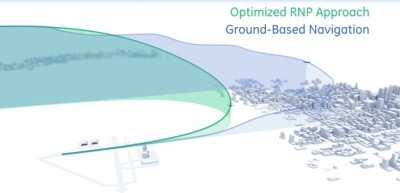No Issues Reported With First Landing Using New GE-Developed
RNP Flight Path
 An American Airlines flight arriving at Bradley International
Airport in Connecticut Thursday afternoon became the first-ever
U.S. flight to use a publicly available, commercially designed
instrument flight path.
An American Airlines flight arriving at Bradley International
Airport in Connecticut Thursday afternoon became the first-ever
U.S. flight to use a publicly available, commercially designed
instrument flight path.
Naverus, a part of GE Aviation, designed the path, which
incorporates Required Navigation Performance technology (RNP), a
core component of the FAA’s NextGen airspace modernization
plan. RNP paths can be custom-tailored to reduce airport
congestion, shorten trip distance, reduce an aircraft’s time
in flight, and create community-friendly flight trajectories that
lessen the effect of aircraft noise.
“Today’s (Thursday's) event marks a significant
milestone for the flying public by augmenting the means to develop
and deploy airspace improvements in the U.S. that will translate to
fewer delays, less air pollution and greater system
reliability,” said Naverus General Manager Steve Forte.
“Modernizing the U.S. air traffic management system is a
monumental task that requires the best efforts of government and
private sectors alike.”
 The new landing procedure, which is a permanent procedure at
Bradley Airport as of Thursday, allows pilots to use onboard
technology to follow a precise track, independent of aging
ground-based navigation beacons that limit where the aircraft can
go. As a result, the Bradley procedure will enable airliners to
land on Runway 15 during periods of low clouds and visibility that
previously would have prevented them from using the runway.
The Bradley Airport RNP approach was specifically designed to
provide pilots with continuous vertical guidance to Runway 15 while
allowing them to land when the cloud ceiling is as low as 350 feet
above the ground. Prior to the new RNP approach, the existing
instrument approach procedure for the runway provided no continuous
vertical flight guidance and was of no benefit to airlines when
cloud ceilings were lower than 1,000 feet above the ground.
It’s anticipated that the new RNP approach will improve the
utility of Bradley’s Runway 15 and provide pilots and
controllers with additional navigation flexibility during periods
of adverse weather or winds.
The new landing procedure, which is a permanent procedure at
Bradley Airport as of Thursday, allows pilots to use onboard
technology to follow a precise track, independent of aging
ground-based navigation beacons that limit where the aircraft can
go. As a result, the Bradley procedure will enable airliners to
land on Runway 15 during periods of low clouds and visibility that
previously would have prevented them from using the runway.
The Bradley Airport RNP approach was specifically designed to
provide pilots with continuous vertical guidance to Runway 15 while
allowing them to land when the cloud ceiling is as low as 350 feet
above the ground. Prior to the new RNP approach, the existing
instrument approach procedure for the runway provided no continuous
vertical flight guidance and was of no benefit to airlines when
cloud ceilings were lower than 1,000 feet above the ground.
It’s anticipated that the new RNP approach will improve the
utility of Bradley’s Runway 15 and provide pilots and
controllers with additional navigation flexibility during periods
of adverse weather or winds.
“Over the next 20 years, airspace and airlines around the
world will fundamentally change from how we operate today,”
said Captain Brian Will, American Airlines’ Director –
Airspace Modernization and Advanced Technologies. “This new
procedure is a critical step to help implement NextGen
modernization.”
“The State of Connecticut, Department of Transportation
and Bradley International Airport are proud to be part of this
cutting-edge technology at New England’s second largest
airport,” said Eric N. Waldron, A.A.E., ACE, Bradley’s
Administrator. “Thank you to GE Aviation, American Airlines
and our partners at the Federal Aviation Administration for
bringing this additional safety feature to Bradley which benefits
everyone, most especially our customers.”
The inaugural flight using the newly-approved approach to
Bradley’s Runway 15 was American Airlines Flight 1916, which
arrived from Dallas/Fort Worth International Airport at 12:11 p.m.
Thursday. Captain Will was at the controls of the Boeing 737 NG,
which carried as a passenger GE Aviation Systems Technical Fellow
for Air Traffic Management, Steve Fulton, a long-time champion of
RNP who developed the world’s first RNP flight paths in the
mid 1990s.

GE-RNP Approach Animation Still Shot
GE says it has deployed effective RNP procedures around the
world and is the first third-party procedure designer to publish a
public RNP procedure in the U.S. In Canada, China, Australia, New
Zealand, Peru and now, the United States, GE’s RNP procedures
are in regular daily use.
GE is working with the FAA and other regulatory bodies and
navigation service providers to develop the capability for aircraft
to share optimized flight trajectories with air traffic control in
real time, and to ‘negotiate’ modifications to those
trajectories when necessary. This ultimately will allow airlines to
plan each and every flight to operate on the most efficient flight
path with the least possible environmental impact.
Navigational and operational capabilities such as these will
make air traffic management more efficient by helping airlines plan
more direct routes, decreasing airspace congestion, saving fuel and
reducing commercial aviation’s greenhouse gas
emissions—which have increased 80 percent over the past 20
years. Without new RNP flight paths and other essential upgrades,
FAA estimates that by 2015 the current air traffic control system
will be unable to handle the 50 percent increase in airplanes and
passengers expected over the next decade.
 ANN's Daily Aero-Linx (04.13.24)
ANN's Daily Aero-Linx (04.13.24) ANN's Daily Aero-Term (04.13.24): Beyond Visual Line Of Sight (BVLOS)
ANN's Daily Aero-Term (04.13.24): Beyond Visual Line Of Sight (BVLOS) Airborne 04.09.24: SnF24!, Piper-DeltaHawk!, Fisher Update, Junkers
Airborne 04.09.24: SnF24!, Piper-DeltaHawk!, Fisher Update, Junkers Aero-News: Quote of the Day (04.14.24)
Aero-News: Quote of the Day (04.14.24) ANN's Daily Aero-Term (04.14.24): Maximum Authorized Altitude
ANN's Daily Aero-Term (04.14.24): Maximum Authorized Altitude





